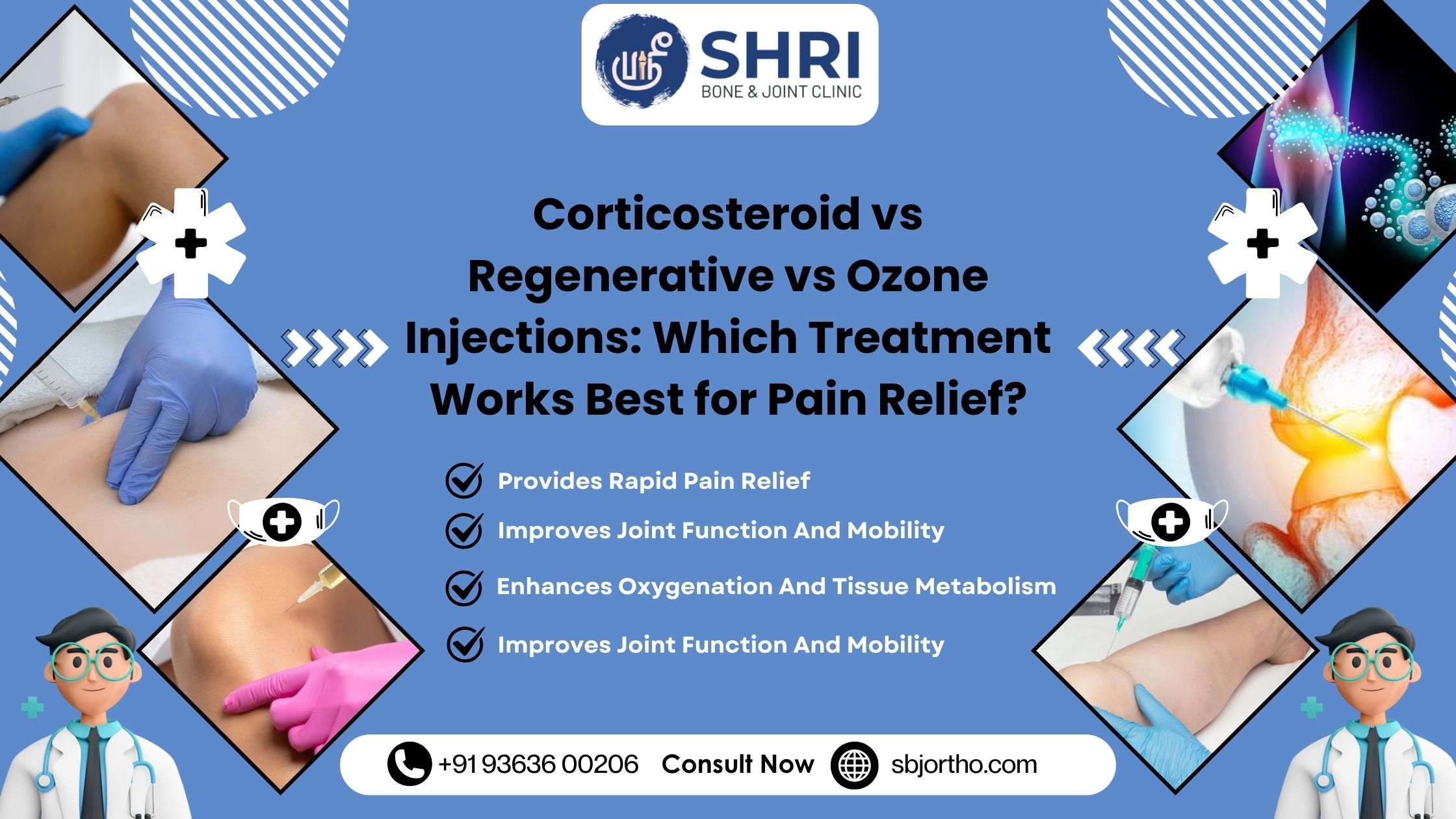Managing joint and spine pain can be challenging, especially when daily activities begin to feel difficult or uncomfortable. As modern medicine continues to advance, several minimally invasive injection-based treatments have emerged to help patients find relief without surgery. Among the most commonly recommended options are corticosteroids, regenerative therapies, and ozone-based treatments.
Although all three methods aim to reduce pain, their mechanisms, benefits, and long-term outcomes differ significantly.
This guide explores each treatment in depth, helping patients understand how they work and which option may be the most suitable based on symptoms, medical history, and long-term goals.
Understanding Why Injections Are Used for Pain Relief
Before diving into specific treatments, it’s helpful to understand why injections are used in pain management.
Most joint and spine pain arises from inflammation, cartilage wear, nerve irritation, or soft-tissue strain. Oral medications may provide temporary relief, but they often cannot target deeper structures. Injections deliver medication or biological agents directly into the affected area, offering:
- Faster and more targeted relief
- Reduced need for oral pain medications
- Support for mobility and rehabilitation
- Minimized systemic side effects
Based on the condition—whether arthritis, tendon irritation, nerve compression, or degenerative changes—different types of injections may be preferred.
1. Corticosteroid Injections: Quick Relief for Inflammation and Swelling
A corticosteroid injection is one of the most widely used treatments for joint and spine-related pain. Steroids are powerful anti-inflammatory medications that help calm irritation in the affected area. They are often recommended for:
- Arthritis flare-ups
- Bursitis or tendonitis
- Nerve-related pain
- Sciatica and spinal inflammation
- Shoulder, knee, or hip pain
- Pain that interferes with daily movement
How They Work
Steroids reduce the production of inflammatory chemicals inside the joint or around the nerve. This helps:
- Lower swelling
- Improve mobility
- Reduce stiffness
- Decrease pain intensity
Many patients experience relief within a few days, and the benefits may last several weeks to a few months depending on their condition.
Advantages
- Rapid reduction in inflammation
- Good short-term relief
- Useful during severe flare-ups
- Allows better participation in physiotherapy
Limitations
- Relief may be temporary
- Not ideal for repeated long-term use
- Does not repair cartilage or tissue damage
- May not address the underlying cause of degeneration
Corticosteroid injections are best suited for patients seeking quick symptom relief, especially when inflammation plays a major role.
2. Regenerative Injections: Supporting Natural Tissue Repair
A regenerative injection focuses on healing rather than temporary pain reduction. Unlike steroids that suppress inflammation, regenerative therapies aim to stimulate the body’s natural repair mechanisms. They are commonly recommended for:
- Early to moderate arthritis
- Cartilage thinning
- Tendon or ligament injuries
- Chronic joint pain
- Patients wanting to delay or avoid surgery
How They Work
Regenerative therapies use biologic substances that promote tissue repair and improve joint health. They help:
- Enhance cellular healing
- Improve lubrication
- Strengthen ligaments and tendons
- Slow degenerative progression
- Reduce stiffness with long-term benefit
Although results develop gradually, regenerative injections often provide more sustained relief.
Advantages
- Targets the underlying cause of pain
- Helps improve joint structure
- Minimally invasive
- Long-lasting benefits
- Suitable for active individuals
- Helps delay knee or joint replacement
Limitations
- Slower onset of relief compared to steroids
- Multiple sessions may be needed
- Not fully covered by insurance in many cases
Regenerative injections work particularly well for patients who want long-term improvement and cartilage support rather than short-term symptom control.
3. Ozone Therapy and Ozone Injections: Natural, Anti-Inflammatory Healing
Ozone therapy and ozone injections use medical-grade ozone gas to reduce inflammation, improve oxygen delivery, and enhance tissue repair. These treatments are widely used for knee arthritis, chronic pain, and inflammatory joint conditions.
How They Work
Ozone promotes healing in multiple ways:
- Reduces oxidative stress
- Improves blood flow and tissue oxygenation
- Helps reduce swelling inside the joint
- Supports cartilage and soft-tissue repair
- Enhances joint lubrication
While not as rapid as steroid-based treatments, many patients report steady improvement over several weeks.
Advantages
- Minimally invasive and safe
- Natural and drug-free
- Helps reduce dependency on pain medications
- Useful for chronic knee pain and arthritis
- Can be repeated as needed
Limitations
- Works gradually, not immediately
- Multiple sessions may be required
- May not be ideal for severe arthritis
Ozone-based treatments are preferred by patients who want non-steroidal, gentle therapies with minimal side effects.
Comparing the Three Treatments Side-by-Side
| Feature | Corticosteroid Injection | Regenerative Injection | Ozone Therapy / Ozone Injections |
| Primary Purpose | Reduce inflammation | Support healing & regeneration | Improve oxygenation & reduce swelling |
| Onset of Relief | Fast (2–5 days) | Gradual (2–6 weeks) | Gradual (2–6 weeks) |
| Duration of Effect | Weeks to months | Months or longer | Several weeks to months |
| Treats Underlying Cause? | No | Yes | Partially |
| Best For | Flare-ups, severe inflammation | Early arthritis, tissue damage | Chronic pain, patients avoiding steroids |
| Surgical Delay Potential | Low | High | Moderate |
| Number of Sessions | 1 (repeat as needed) | 1–3 sessions | 3–6 sessions |
How to Know Which Injection Is Right for You
Choosing the right treatment depends on several factors:
1. Nature of Pain
- Sharp inflammatory pain: Steroids may provide quick relief.
- Degenerative or chronic joint wear: Regenerative injections may help more.
- Long-term knee discomfort: Ozone therapy may be effective.
2. Severity of the Condition
- Mild to moderate arthritis responds well to regenerative and ozone-based therapies.
- Severe inflammation or acute flare-ups respond better to steroids.
3. Desired Timeline of Relief
- Immediate relief → corticosteroids
- Long-term improvement → regenerative options
- Natural therapy with gradual benefit → ozone injections
4. Overall Health & Medical Preferences
Patients unable to take steroids or anti-inflammatory medications often benefit from ozone or regenerative treatments.
5. Activity Level
Active individuals looking for sustained improvement generally prefer regenerative options.
Conclusion
Corticosteroid, regenerative, and ozone-based injections all play important roles in modern pain management, but they serve different purposes. Steroid injections help control inflammation quickly, regenerative treatments support tissue repair for long-term benefit, and ozone-based therapies offer natural healing for chronic discomfort.
The most suitable option depends on the patient’s condition, medical history, pain severity, and long-term treatment goals. Understanding how each therapy works empowers patients to make informed decisions and explore the best non-surgical solutions for pain relief and improved joint function.

